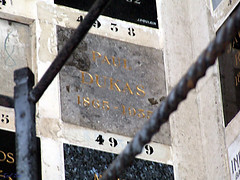Paul Dukas - Symphony in C Major (1895). Conducted by Yan Pascal Tortelier with the BBC Philharmonic Orchestra.
 |
| English: Paul Dukas (1865-1935), French composer. (Photo credit: Wikipedia) |
II. Andante Espressivo E Sostenuto - 14:47
III. Allegro Spiritoso - 29:44
Paul Abraham Dukas (1 October 1865 -- 17 May 1935) was a French composer, critic, scholar and teacher. A studious man, of retiring personality, he was intensely self-critical, and he abandoned and destroyed many of his compositions. His best known work is the orchestral piece, L'apprenti sorcier (The Sorcerer's Apprentice), the fame of which has eclipsed that of his other surviving works. Among these are an opera Ariane et Barbe-bleue (Ariadne and Bluebeard), a symphony, two substantial works for solo piano, and a ballet, La Péri.
The Symphony in C major was composed in 1895--96, when Dukas was in his early 30s. It is dedicated to Paul Vidal, and had its first performance in January 1896, under the direction of the dedicatee. In a study of Dukas published towards the end of the composer's life, Irving Schwerké wrote, "The work ... is an opulent expression of modernism in classical form. Its ideational luxuriance, nobility of utterance and architectural solidity mark it as one of the most conspicuous achievements of contemporaneous writing, and magnificently refute the generally prevalent notion that no French composer has ever produced a great symphony." Like Franck's only symphony, Dukas's is in three movements rather than the conventional four.
Schwerké wrote of it:
 |
| Paul Dukas (Photo credit: CedEm photographies) |










